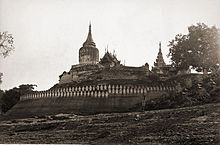Bagan
Bagan (Burmese: ပုဂံ; MLCTS: pu.gam, IPA: [bəɡàɰ̃]; formerly Pagan) is an ancient city and a UNESCO World Heritage Site in the Mandalay Region of Myanmar.
Its other names in Pali are in reference to its extreme dry zone climate: Tattadesa (တတ္တဒေသ, "parched land"), and Tampadīpa (တမ္ပဒီပ, "bronzed country").
[6] Western scholarship however holds that Bagan was founded in the mid-to-late 9th century by the Mranma (Burmans), who had recently entered the Irrawaddy valley from the Nanzhao Kingdom.
While the royal patronage of Theravada Buddhism since the mid-11th century had enabled the Buddhist school to gradually gain primacy, other traditions continued to thrive throughout the Pagan period to degrees later unseen.
A main strip extending for about 9 km along the east bank of the Irrawaddy emerged during this period, with the walled core (known as "Old Bagan") in the middle.
[9]: 50–1 By the 13th century, the area around Old Bagan was already densely packed with monuments, and new major clusters began to emerge to the east.
Michael Aung-Thwin has suggested that the smaller sizes may indicate "dwindling economic resources" and that the clustering around monasteries may reflect growing monastic influence.
The prolific temple building alone would have been a huge stimulus for professions involved in their construction, such as brickmaking and masonry; gold, silver, and bronze working; carpentry and woodcarving; and ceramics.
Finished temples would still need maintenance work done, so they continued to boost demand for both artisans' services and unskilled labor well after their construction.
Contemporary inscriptions indicate that "people of many linguistic and cultural backgrounds lived and worked" in Bagan during this time period.
[10]: 305–7 Bagan's ascendancy also coincided with a period of political and economic decline in several other nearby regions, like Dvaravati, Srivijaya, and the Chola Empire.
[11] According to Michael Aung-Thwin, a more likely explanation is that the provincial governors tasked with defending against Mongol incursions were so successful that they became "the new power elite", and their capitals became the new political centers while Bagan itself became a backwater.
Then came a series of state-sponsored "systematic" renovations in the Konbaung period (1752–1885), which by and large were not true to the original designs—some finished with "a rude plastered surface, scratched without taste, art or result".
[18] Many of these damaged pagodas underwent restorations in the 1990s by the military government, which sought to make Bagan an international tourist destination.
Critics were aghast that the restorations paid little attention to original architectural styles, and used modern materials, and that the government has also established a golf course, a paved highway, and built a 61 m (200 ft) watchtower.
Unlike the coastal regions of the country, which receive annual monsoon rainfalls exceeding 2,500 mm (98 in), the dry zone gets little precipitation as it is sheltered from the rain by the Rakhine Yoma mountain range in the west.
Bagan stands out for not only the sheer number of religious edifices of Myanmar but also the magnificent architecture of the buildings, and their contribution to Burmese temple design.
[26] Originally, a Ceylonese stupa had a hemispheric body (Pali: anda "the egg"), on which a rectangular box surrounded by a stone balustrade (harmika) was set.
By the 11th century, the stupa had developed into a more bell-shaped form in which the parasols morphed into a series of increasingly smaller rings placed on one top of the other, rising to a point.
Three or four rectangular terraces served as the base for a pagoda, often with a gallery of terra-cotta tiles depicting Buddhist jataka stories.
[29] In contrast to the stupas, the hollow gu-style temple is a structure used for meditation, devotional worship of the Buddha and other Buddhist rituals.
[30] Although the Burmese temple designs evolved from Indic, Pyu (and possibly Mon) styles, the techniques of vaulting seem to have developed in Bagan itself.
In the 18th century, for example, King Bodawpaya attempted to build the Mingun Pagoda, in the form of spacious vaulted chambered temple but failed as craftsmen and masons of the later era had lost the knowledge of vaulting and keystone arching to reproduce the spacious interior space of the Bagan hollow temples.
The Irrawaddy has certainly eroded at least some parts of the city, since there are "buildings collapsing into the river both upstream and downstream from the walled core".
[9]: 66 An important outlying site is at Otein Taung, 2 km south of the Ananda temple in the walled city of Old Bagan.
Also found were small charcoal fragments, preserved burnt bamboo filaments, and some animal bones and pigs' teeth.
[9]: 53–4, 61, 70 The sprinkler pot, or kendi, is a very characteristic type of pottery from medieval Myanmar, and over 50 spouts and necks belonging to them were found by archaeologists at Otein Taung.
[9]: 58–9 It is not clear whether Otein Taung represents a large-scale pottery production site or "a huge, and for Bagan unique, residential midden".
The anvils are common potters' tools in South and Southeast Asia: they are held inside a pot while the outside is beaten with a paddle.
[9]: 55–6 If Otein Taung was used as a pottery production site, then it would have had good access to natural clay resources: the Bagan area has clayey subsoil that is "still mined today for brickmaking".







